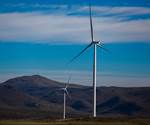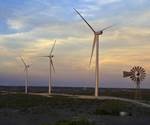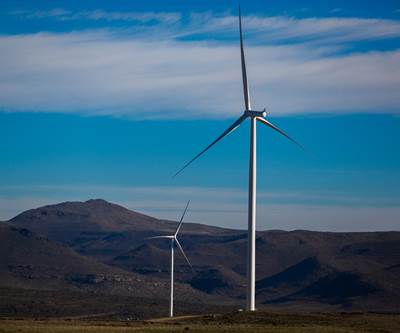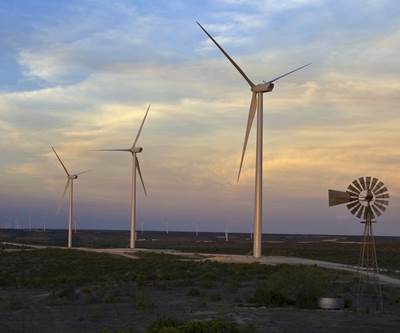Decommissioned wind turbine blades used for cement co-processing
An initiative to recycle wind turbine blades includes the use of recycled glass fiber composites for cement manufacturing, replacing raw material and saving energy.
A recently announced project by a group of European wind and chemical industry partners has been formed to advance recycling efforts for composite wind blades. The partnership includes WindEurope (Brussels, Belgium), the European Chemical Industry Council (CEFIC, Brussels, Belgium) and the European Composites Industry Association (EuCIA, Brussels, Belgium).
There are more than 2.5 million tons of composite material in use in the wind energy sector with 130,000 wind turbines active in the European Union (EU) today. But as the industry develops, aging turbines will need to be replaced — in the next five years 12,000 wind turbines are expected to be decommissioned. Broadening the range of recycling options is critical as the industry continues to grow.
WindEurope CEO Giles Dickson explains, “Wind energy is an increasingly important part of Europe’s energy mix. The first generation of wind turbines are now starting to come to the end of their operational life and be replaced by modern turbines. Recycling the old blades is a top priority for us, and teaming up with the chemical and compositors industries will enable us to do it the most effective way.”
One of the areas being explored is the use of recycled wind blade material as filler for cement in a process that is said to reduce the carbon dioxide output of the cement manufacturing process by up to 16%. The members of CEFIC, including Ashland (Covington, Ky., U.S.), AOC Aliancys (Collierville, Tenn., U.S.; Schaffhausen, Switzerland), Polynt (Miehlen, Germany; Bergamo, Italy) and Scott Bader (Northamptonshire, U.K.), among others, are supporting the efforts of promoting cement production as true recycling. Composite materials are being recycled today at commercial scale through cement co-processing, where the cement raw materials such as silica are being partially replaced by the glass fibres and fillers in the composite, while the organic fraction is burned in the process for energy, replacing coal. The wind blades can be broken down by the grinding equipment on location, so there is no need to ship entire blades to a recycling point.
The process boasts the re-use of raw materials as well as energy recovery and reduction of CO2. Currently the process is only sutable for glass reinforced composites, but the partnership is exploring a number of solutions for recycling aging wind turbines. Besides recycling through cement co-processing, alternative technologies like mechanical recycling, solvolysis and pyrolysis are being developed, ultimately providing the industry with additional solutions for end of life.
“As a global supplier to wind blade and nacelle producers, we hope to set an industry standard where learnings from wind turbine recycling will then be transferred to other markets to enhance the overall sustainability of composites,” says Stefan Osterwind, vice president of Europe, the Middle East, Africa and India (EMEA & India) for Ashland and chairman of the CEFIC UPR sector group.
“The chemical industry plays a decisive role in the transition to a circular economy by investing in the research and development of new materials, which make wind turbine blades more reliable, affordable and recyclable,” says CEFIC Director General, Marco Mensink. “Innovation is born from collaboration and we look forward to working together to advance wind turbine blade recycling.”
EUCIA president Roberto Frassine adds, “The wind energy sector has always been at the forefront of using composites as they are instrumental to sustainable energy generation. With this collaboration we hope to set a great industry standard that ultimately will also help customers in other industries like marine and building, and infrastructure.”
Related Content
Materials & Processes: Resin matrices for composites
The matrix binds the fiber reinforcement, gives the composite component its shape and determines its surface quality. A composite matrix may be a polymer, ceramic, metal or carbon. Here’s a guide to selection.
Read MoreASCEND program update: Designing next-gen, high-rate auto and aerospace composites
GKN Aerospace, McLaren Automotive and U.K.-based partners share goals and progress aiming at high-rate, Industry 4.0-enabled, sustainable materials and processes.
Read MorePlant tour: Middle River Aerostructure Systems, Baltimore, Md., U.S.
The historic Martin Aircraft factory is advancing digitized automation for more sustainable production of composite aerostructures.
Read MoreMaterials & Processes: Fabrication methods
There are numerous methods for fabricating composite components. Selection of a method for a particular part, therefore, will depend on the materials, the part design and end-use or application. Here's a guide to selection.
Read MoreRead Next
Joint project to advance wind turbine blade recycling
A group of European wind and chemical industry partners aims to broaden the range of recycling options for composite wind blades.
Read MoreAWEA reports U.S. wind energy growth of 8 percent in 2018
The American Wind Energy Association also reports growth in wind energy jobs, revenues of more than $1 billion from wind energy and expected offshore wind growth.
Read MoreCW’s 2024 Top Shops survey offers new approach to benchmarking
Respondents that complete the survey by April 30, 2024, have the chance to be recognized as an honoree.
Read More
.png;width=70;height=70;mode=crop)












.jpg;maxWidth=300;quality=90)












